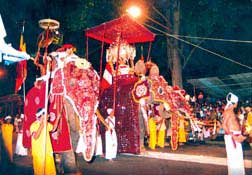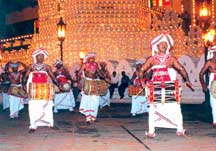
|
|||||||
|
| |||||||
Elephants, acrobats enliven ancient Sri Lankan Buddhist festival
The colourful parade began Saturday night from the sacred Buddhist shrine of Dalada Maligawa, showcasing the temple custodians known as Nilames, who were dressed up like ancient kings. The festivities also included traditional Kandyan dancers, fire-juggling acrobats, palanquins, musicians and torchbearers, who followed the elephants through the streets. Kandy Perahera is celebrated annually ever since the sacred tooth relic of Buddha was brought to Sri Lanka during the reign of King Kirthi Sri Meghavanna during 300 A.D. Similar festivals take place in other parts of the country, including capital Colombo, but on a smaller scale. The grand finale of the 10-day celebrations in Kandy, known as Randoli Perahera, began at an auspicious time at 8 p.m. Saturday. Thousands of Sri Lankans and hundreds of foreigners, including the Colombo-based diplomatic corps, attended the night of pageantry. According to organisers, over 3,000 police personnel and hundreds of military personnel, were on guard to ensure that the event remained trouble-free. Dalada Maligawa was also hit by the decades-long ethnic war when a suicide cadre of the Tamil Tiger rebels blew up an explosive-laden truck right in front of the temple, causing damage to the shrine in April 1998. But the temple faced the first attack during the insurrection of the radical Marxist Janatha Vimukthi Peramuna (JVP) in the 1980’s. The highlight of Saturday’s parade was the brightly festooned Maligawa Tusker called Raja, the biggest elephant in the procession, proudly carrying the Perahera Karanduwa, the replica of the casket in which the sacred tooth relic of Lord Buddha is kept. The actual relic is kept inside seven caskets in the inner sanctum of the Dalada Maligawa. On the directions of the mahouts, Raja and other elephants walked in measured steps and seemed as though they were moving to the beats of the traditional drummers. In Sri Lanka, the lives of elephants are interwoven with those of humans. They are a part of the history, culture, religion and tradition of the island nation, which has 20 million people and nearly 4,000 elephants. The procession was flanked by torch-bearers, who steadfastly carried long, flaming wooden poles. Although the country has been suffering from one of the bloodiest ethnic conflicts, this colourful pageant in Kandy symbolises the religious harmony and ethnic unity among the two main communities - the Sinhala-Buddhist and the Tamil Hindus. Anuradha Seneviratne, a professor of the Peradeniya University, said that apart from its religious significance, the event provides a platform to traditional folk artistes to exhibit their reverence and devotion to the enlightened one - the Buddha - and to gods and goddesses such as Natha, Vishnu, Kataragama (lord Muruga) and Pattini. In one of his books on the Kandy Perahera, Seneviratne writes says that the characteristic of the annual Kandy pageant has gone through a transformation over the years. ‘The Perahera of yesteryears reflected the spirit, the socio-cultural milieu and the political and administrative structure of the times (feudal and monarch elements). (But) The Peraheras today, though portraying semblance of its past grandeur, has transformed into a mere folk pageant,’ he writes. Courtesy: Barefoot SriLanka
|
 Nearly 100 caparisoned elephants, dancers and torchbearers walked down the streets of this central city decorated with colourful lights and flags as the annual Buddhist festival of Kandy Perahera (pageant) was celebrated with great enthusiasm.
Nearly 100 caparisoned elephants, dancers and torchbearers walked down the streets of this central city decorated with colourful lights and flags as the annual Buddhist festival of Kandy Perahera (pageant) was celebrated with great enthusiasm.